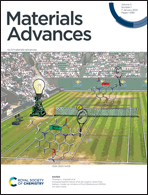Synthesis of few-layer MoS2@N-doped carbon core–shell hollow spheres using a cationic surfactant as a template for highly stable lithium-ion storage†
Abstract
Molybdenum disulfide (MoS2) is a promising anode material for lithium-ion batteries (LIBs) because of its high theoretical capacity. But its rapid capacity decay due to poor conductivity, structure pulverization, and polysulfide dissolution presents challenges for practical applications. In this work, an innovative cationic surfactant templating route to one-step synthesizing epitaxial few-layer MoS2@N-doped carbon (EF-MoS2@NC) core–shell hollow structures is developed via an electrostatic interaction S+X−I+ pathway. Compared with general hard-template strategies, the soft-template method proposed here is simplified, avoiding the cumbersome coating and template removal process. The internal hollow space and outer NC protective layer can accommodate the large volumetric expansion of MoS2 and preserve the structural integrity of the electrode preventing polysulphide dissolution. When evaluated as anode materials for LIBs, the core–shell EF-MoS2@NC hollow spheres achieve a high discharge capacity of 928 mA h g−1 after 100 cycles at 0.1 A g−1. More importantly, a reversible capacity of 829 mA h g−1 could be obtained at 1.0 A g−1 after 1000 cycles, which demonstrates good stability.



 Please wait while we load your content...
Please wait while we load your content...